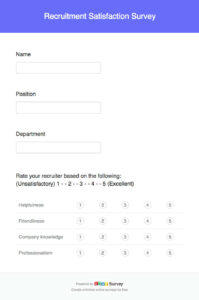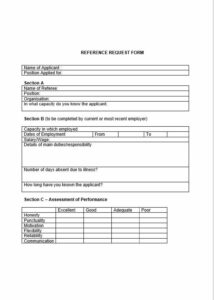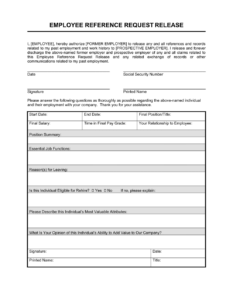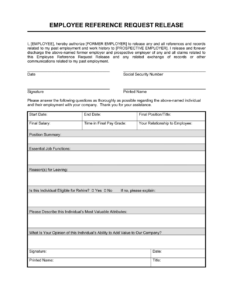Utilizing a pre-designed structure offers several advantages. It saves time and effort for both the hiring manager and the reference provider. Clear, specific questions prompt detailed and relevant responses, reducing ambiguity and back-and-forth communication. This standardized format also ensures legal compliance by focusing on job-related inquiries and promoting fair evaluation practices. Moreover, it enhances the professionalism of the hiring process, reflecting positively on the organization.
The following sections will explore the key components of these valuable tools, offering practical guidance on their creation and implementation for optimal effectiveness in recruitment and selection.
Key Components of an Employment Reference Request
Effective reference requests contain essential elements that ensure thorough and consistent information gathering. These components facilitate efficient evaluation of candidates while maintaining professionalism and legal compliance.
1. Candidate Information: Including the candidate’s full name and the position they applied for provides context for the reference provider.
2. Requestor Information: Contact details for the hiring manager or HR representative allow for direct communication and clarification if needed.
3. Company Information: Details about the organization requesting the reference, including its name and address, establish legitimacy and professionalism.
4. Dates of Employment Verification: Requesting confirmation of the candidate’s employment dates ensures accuracy and helps verify the information provided by the candidate.
5. Job Title and Responsibilities: Inquiring about the candidate’s previous role and responsibilities provides insight into their experience and skill set.
6. Performance Evaluation: Questions regarding the candidate’s performance, strengths, and weaknesses offer valuable insights into their capabilities and work ethic.
7. Eligibility for Rehire: This question can reveal important information about the candidate’s overall suitability and previous work history.
8. Open-Ended Feedback: Providing space for additional comments allows the reference provider to share any relevant information not covered by the specific questions.
A well-designed request form ensures a streamlined process, facilitating informed decision-making during candidate selection. Careful consideration of these components contributes to a comprehensive and efficient evaluation.
How to Create an Employment Reference Request
Creating a standardized request form ensures consistency and efficiency in gathering information from potential employee references. A well-structured template facilitates thorough evaluation and informed hiring decisions.
1. Establish Contact Information: Begin by clearly identifying the requesting organization, including its name, address, and contact person. Provide contact details for convenient communication.
2. Identify the Candidate: Clearly state the candidate’s full name and the position for which they have applied. This context is crucial for the reference provider.
3. Verify Employment Dates: Request confirmation of the candidate’s employment start and end dates with the previous employer. This step helps verify information provided by the candidate.
4. Inquire About Job Responsibilities: Include specific questions about the candidate’s previous roles and responsibilities to gain insight into their experience and skills.
5. Request Performance Feedback: Structure questions to elicit feedback on the candidate’s performance, strengths, and areas for development. This offers valuable insight into their work ethic and capabilities.
6. Address Rehire Eligibility: Inquire whether the previous employer would consider rehiring the candidate. This question can reveal important information about their overall suitability.
7. Include Open-Ended Questions: Provide space for additional comments or observations. This allows the reference provider to share any pertinent information not covered by structured questions.
8. Maintain Professionalism and Compliance: Ensure all questions comply with relevant legal and ethical guidelines. Focus on job-related inquiries and avoid discriminatory or biased questions.
A standardized approach to reference requests facilitates efficient and objective candidate evaluation. This structured format ensures consistency, promotes fairness, and contributes to well-informed hiring decisions.
Standardized forms for gathering candidate information from previous employers are crucial for effective recruitment. These tools ensure consistency, efficiency, and legal compliance throughout the hiring process. Key components include verifying employment dates, understanding past roles and responsibilities, assessing performance, and determining rehire eligibility. Creating a well-structured template involves clearly identifying the requesting organization and candidate, posing specific and open-ended questions, and maintaining professional and ethical standards. A systematic approach to requesting and evaluating references facilitates informed decision-making and contributes to successful recruitment outcomes.
Leveraging structured reference requests promotes a more thorough and objective candidate evaluation process. Organizations that prioritize these best practices contribute to building strong, capable teams while minimizing potential risks. As the employment landscape evolves, the strategic use of these tools will remain essential for effective talent acquisition and organizational success.



